Effects of Climatic Conditions on the Lying Behavior of a Group of Primiparous Dairy Cows
Simple Summary
Abstract
1. Introduction
2. Materials and Methods
2.1. Animals and Housing
2.2. Behavioral Data
2.3. Environmental Data
2.4. Data Processing and Statistical Analysis
3. Results
Behavioral and Environmental Data
4. Discussion
5. Conclusions
Author Contributions
Funding
Acknowledgments
Conflicts of Interest
References
- Solano, L.; Barkema, H.W.; Pajor, E.A.; Mason, S.; LeBlanc, S.J.; Nash, C.G.R.; Haley, D.B.; Pellerin, D.; Rushen, J.; de Passillé, A.M.; et al. Associations between lying behavior and lameness in Canadian Holstein-Friesian cows housed in freestall barns. J. Dairy Sci. 2016, 99, 2086–2101. [Google Scholar] [CrossRef] [PubMed]
- Westin, R.; Vaughan, A.; de Passillé, A.M.; DeVries, T.J.; Pajor, E.A.; Pellerin, D.; Siegford, J.M.; Vasseur, E.; Rushen, J. Lying times of lactating cows on dairy farms with automatic milking systems and the relation to lameness, leg lesions, and body condition score. J. Dairy Sci. 2016, 99, 551–561. [Google Scholar] [CrossRef] [PubMed]
- Bach, A.; Pinto, A.; Guasch, I. Case study: Lying behavior of dairy cows presented with different cubicle arrangements. Prof. Anim. Sci. 2016, 32, 110–114. [Google Scholar] [CrossRef]
- Munksgaard, L.; Jensen, M.B.; Pedersen, L.J.; Hansen, S.W.; Matthews, L. Quantifying behavioural priorities—effects of time constraints on behaviour of dairy cows, Bos taurus. Appl. Anim. Behav. Sci. 2005, 92, 3–14. [Google Scholar] [CrossRef]
- Fregonesi, J.A.; Tucker, C.B.; Weary, D.M. Overstocking reduces lying time in dairy cows. J. Dairy Sci. 2007, 90, 3349–3354. [Google Scholar] [CrossRef]
- Jacobs, J.A.; Siegford, J.M. Invited review: The impact of automatic milking systems on dairy cow management, behavior, health, and welfare. J. Dairy Sci. 2012, 95, 2227–2247. [Google Scholar] [CrossRef]
- Fregonesi, J.A.; Leaver, J.D. Behaviour, performance and health indicators of welfare for dairy cows housed in strawyard or cubicle systems. Livest. Prod. Sci. 2001, 68, 205–216. [Google Scholar] [CrossRef]
- Kok, A.; van Knegsel, A.T.M.; van Middelaar, C.E.; Hogeveen, H.; Kemp, B.; de Boer, I.J.M. Technical note: Validation of sensor-recorded lying bouts in lactating dairy cows using a 2-sensor approach. J. Dairy Sci. 2015, 98, 7911–7916. [Google Scholar] [CrossRef]
- Mattachini, G.; Riva, E.; Provolo, G. The lying and standing activity indices of dairy cows in free-stall housing. Appl. Anim. Behav. Sci. 2011, 129, 18–27. [Google Scholar] [CrossRef]
- Neave, H.W.; Lomb, J.; Weary, D.M.; LeBlanc, S.J.; Huzzey, J.M.; von Keyserlingk, M.A.G. Behavioral changes before metritis diagnosis in dairy cows. J. Dairy Sci. 2018, 101, 4388–4399. [Google Scholar] [CrossRef]
- Siivonen, J.; Taponen, S.; Hovinen, M.; Pastell, M.; Lensink, B.J.; Pyörälä, S.; Hänninen, L. Impact of acute clinical mastitis on cow behaviour. Appl. Anim. Behav. Sci. 2011, 132, 101–106. [Google Scholar] [CrossRef]
- Itle, A.J.; Huzzey, J.M.; Weary, D.M.; von Keyserlingk, M.A.G. Clinical ketosis and standing behavior in transition cows. J. Dairy Sci. 2015, 98, 128–134. [Google Scholar] [CrossRef] [PubMed]
- Vázquez Diosdado, J.A.; Barker, Z.E.; Hodges, H.R.; Amory, J.R.; Croft, D.P.; Bell, N.J.; Codling, E.A. Classification of behaviour in housed dairy cows using an accelerometer-based activity monitoring system. Anim. Biotelemetry 2015, 3, 15. [Google Scholar] [CrossRef]
- Tullo, E.; Fontana, I.; Gottardo, D.; Sloth, K.H.; Guarino, M. Technical note: Validation of a commercial system for the continuous and automated monitoring of dairy cow activity. J. Dairy Sci. 2016, 99, 7489–7494. [Google Scholar] [CrossRef] [PubMed]
- Porto, S.M.C.; Arcidiacono, C.; Anguzza, U.; Cascone, G. A computer vision-based system for the automatic detection of lying behaviour of dairy cows in free-stall barns. Biosyst. Eng. 2013, 115, 184–194. [Google Scholar] [CrossRef]
- Mattachini, G.; Riva, E.; Bisaglia, C.; Pompe, J.C.A.M.; Provolo, G. Methodology for quantifying the behavioral activity of dairy cows in freestall barns. J. Anim. Sci. 2013, 91, 4899–4907. [Google Scholar] [CrossRef]
- Neethirajan, S.; Tuteja, S.K.; Huang, S.T.; Kelton, D. Recent advancement in biosensors technology for animal and livestock health management. Biosens. Bioelectron. 2017, 98, 398–407. [Google Scholar] [CrossRef]
- Deming, J.A.; Bergeron, R.; Leslie, K.E.; DeVries, T.J. Associations of housing, management, milking activity, and standing and lying behavior of dairy cows milked in automatic systems. J. Dairy Sci. 2013, 96, 344–351. [Google Scholar] [CrossRef]
- de Vries, M.; Bokkers, E.A.M.; van Reenen, C.G.; Engel, B.; van Schaik, G.; Dijkstra, T.; de Boer, I.J.M. Housing and management factors associated with indicators of dairy cattle welfare. Prev. Vet. Med. 2015, 118, 80–92. [Google Scholar] [CrossRef]
- Norring, M.; Valros, A.; Munksgaard, L. Milk yield affects time budget of dairy cows in tie-stalls. J. Dairy Sci. 2012, 95, 102–108. [Google Scholar] [CrossRef]
- Kaufman, E.I.; LeBlanc, S.J.; McBride, B.W.; Duffield, T.F.; DeVries, T.J. Short communication: Association of lying behavior and subclinical ketosis in transition dairy cows. J. Dairy Sci. 2016, 99, 7473–7480. [Google Scholar] [CrossRef] [PubMed]
- Maselyne, J.; Pastell, M.; Thomsen, P.T.; Thorup, V.M.; Hänninen, L.; Vangeyte, J.; Van Nuffel, A.; Munksgaard, L. Daily lying time, motion index and step frequency in dairy cows change throughout lactation. Res. Vet. Sci. 2017, 110, 1–3. [Google Scholar] [CrossRef] [PubMed]
- Ito, K.; Chapinal, N.; Weary, D.M.; Von Keyserlingk, M.A.G. Associations between herd-level factors and lying behavior of freestall-housed dairy cows. J. Dairy Sci. 2014, 97, 2081–2089. [Google Scholar] [CrossRef] [PubMed]
- Adamczyk, K.; Cywicka, D.; Herbut, P.; Trześniowska, E. The application of cluster analysis methods in assessment of daily physical activity of dairy cows milked in the Voluntary Milking System. Comput. Electron. Agric. 2017, 141, 65–72. [Google Scholar] [CrossRef]
- Herbut, P.; Angrecka, S. Relationship between THI level and dairy cows’ behaviour during summer period. Ital. J. Anim. Sci. 2018, 17, 226–233. [Google Scholar] [CrossRef]
- Allen, J.; Anderson, S. Managing Heat Stress and its Impact on Cow Behavior. In Proceedings of the 28th Annual Western Dairy Management Conference, Reno, NV, USA, 6–8 March 2013; Volume 68, pp. 150–162. [Google Scholar]
- Biffani, S.; Bernabucci, U.; Vitali, A.; Lacetera, N.; Nardone, A. Short communication: Effect of heat stress on nonreturn rate of Italian Holstein cows. J. Dairy Sci. 2016, 99, 5837–5843. [Google Scholar] [CrossRef]
- Herbut, P.; Angrecka, S.; Walczak, J. Environmental parameters to assessing of heat stress in dairy cattle—A review. Int. J. Biometeorol. 2018, 62, 2089–2097. [Google Scholar] [CrossRef]
- Moretti, R.; Biffani, S.; Chessa, S.; Bozzi, R. Heat stress effects on Holstein dairy cows’ rumination. Animal 2017, 11, 2320–2325. [Google Scholar] [CrossRef]
- Polsky, L.; von Keyserlingk, M.A.G. Invited review: Effects of heat stress on dairy cattle welfare. J. Dairy Sci. 2017, 100, 8645–8657. [Google Scholar] [CrossRef]
- Summer, A.; Lora, I.; Formaggioni, P.; Gottardo, F. Impact of heat stress on milk and meat production. Anim. Front. 2019, 9, 39–46. [Google Scholar] [CrossRef]
- Abeni, F.; Galli, A. Monitoring cow activity and rumination time for an early detection of heat stress in dairy cow. Int. J. Biometeorol. 2017, 61, 417–425. [Google Scholar] [CrossRef] [PubMed]
- Vitali, A.; Felici, A.; Esposito, S.; Bernabucci, U.; Bertocchi, L.; Maresca, C.; Nardone, A.; Lacetera, N. The effect of heat waves on dairy cow mortality. J. Dairy Sci. 2015, 98, 4572–4579. [Google Scholar] [CrossRef] [PubMed]
- Wang, X.; Gao, H.; Gebremedhin, K.G.; Bjerg, B.S.; Van Os, J.; Tucker, C.B.; Zhang, G. A predictive model of equivalent temperature index for dairy cattle (ETIC). J. Therm. Biol. 2018, 76, 165–170. [Google Scholar] [CrossRef] [PubMed]
- Kibler, H.H. Thermal effects of various temperature-humidity combinations on Holstein cattle as measured by eight physiological responses. Res. Bull. 1964, 862, 1–42. [Google Scholar]
- Bohmanova, J.; Misztal, I.; Cole, J.B. Temperature-Humidity Indices as Indicators of Milk Production Losses due to Heat Stress. J. Dairy Sci. 2007, 90, 1947–1956. [Google Scholar] [CrossRef]
- Schütz, K.E.; Rogers, A.R.; Cox, N.R.; Tucker, C.B. Dairy cows prefer shade that offers greater protection against solar radiation in summer: Shade use, behaviour, and body temperature. Appl. Anim. Behav. Sci. 2009, 116, 28–34. [Google Scholar] [CrossRef]
- Schütz, K.E.; Clark, K.V.; Cox, N.R.; Matthews, L.R.; Tucker, C.B. Responses to short-term exposure to simulated rain and wind by dairy cattle: Time budgets, shelter use, body temperature and feed intake. Anim. Welf. 2010, 19, 375–383. [Google Scholar]
- Tucker, C.B.; Rogers, A.R.; Schütz, K.E. Effect of solar radiation on dairy cattle behaviour, use of shade and body temperature in a pasture-based system. Appl. Anim. Behav. Sci. 2008, 109, 141–154. [Google Scholar] [CrossRef]
- Brzozowska, A.; Łukaszewicz, M.; Sender, G.; Kolasińska, D.; Oprzadek, J. Locomotor activity of dairy cows in relation to season and lactation. Appl. Anim. Behav. Sci. 2014, 156, 6–11. [Google Scholar] [CrossRef]
- Zähner, M.; Schrader, L.; Hauser, R.; Keck, M.; Langhans, W.; Wechsler, B. The influence of climatic conditions on physiological and behavioural parameters in dairy cows kept in open stables. Anim. Sci. 2004, 78, 139–147. [Google Scholar] [CrossRef]
- Galan, E.; Llonch, P.; Villagra, A.; Levit, H.; Pinto, S.; del Prado, A. A systematic review of non-productivity-related animal-based indicators of heat stress resilience in dairy cattle. PLoS ONE 2018, 13, e0206520. [Google Scholar] [CrossRef] [PubMed]
- Schütz, K.E.; Rogers, A.R.; Cox, N.R.; Webster, J.R.; Tucker, C.B. Dairy cattle prefer shade over sprinklers: Effects on behavior and physiology. J. Dairy Sci. 2011, 94, 273–283. [Google Scholar] [CrossRef] [PubMed]
- Van laer, E.; Moons, C.P.H.; Sonck, B.; Tuyttens, F.A.M. Importance of outdoor shelter for cattle in temperate climates. Livest. Sci. 2014, 159, 87–101. [Google Scholar] [CrossRef]
- Stone, A.E.; Jones, B.W.; Becker, C.A.; Bewley, J.M. Influence of breed, milk yield, and temperature-humidity index on dairy cow lying time, neck activity, reticulorumen temperature, and rumination behavior. J. Dairy Sci. 2017, 100, 2395–2403. [Google Scholar] [CrossRef] [PubMed]
- Tucker, C.B.; Rogers, A.R.; Verkerk, G.A.; Kendall, P.E.; Webster, J.R.; Matthews, L.R. Effects of shelter and body condition on the behaviour and physiology of dairy cattle in winter. Appl. Anim. Behav. Sci. 2007, 105, 1–13. [Google Scholar] [CrossRef]
- Webster, J.R.; Stewart, M.; Rogers, A.R.; Verkerk, G.A. Assessment of welfare from physiological and behavioural responses of New Zealand dairy cows exposed to cold and wet conditions. Anim. Welf. 2008, 17, 19–26. [Google Scholar]
- Chen, J.M.; Stull, C.L.; Ledgerwood, D.N.; Tucker, C.B. Muddy conditions reduce hygiene and lying time in dairy cattle and increase time spent on concrete. J. Dairy Sci. 2017, 100, 2090–2103. [Google Scholar] [CrossRef]
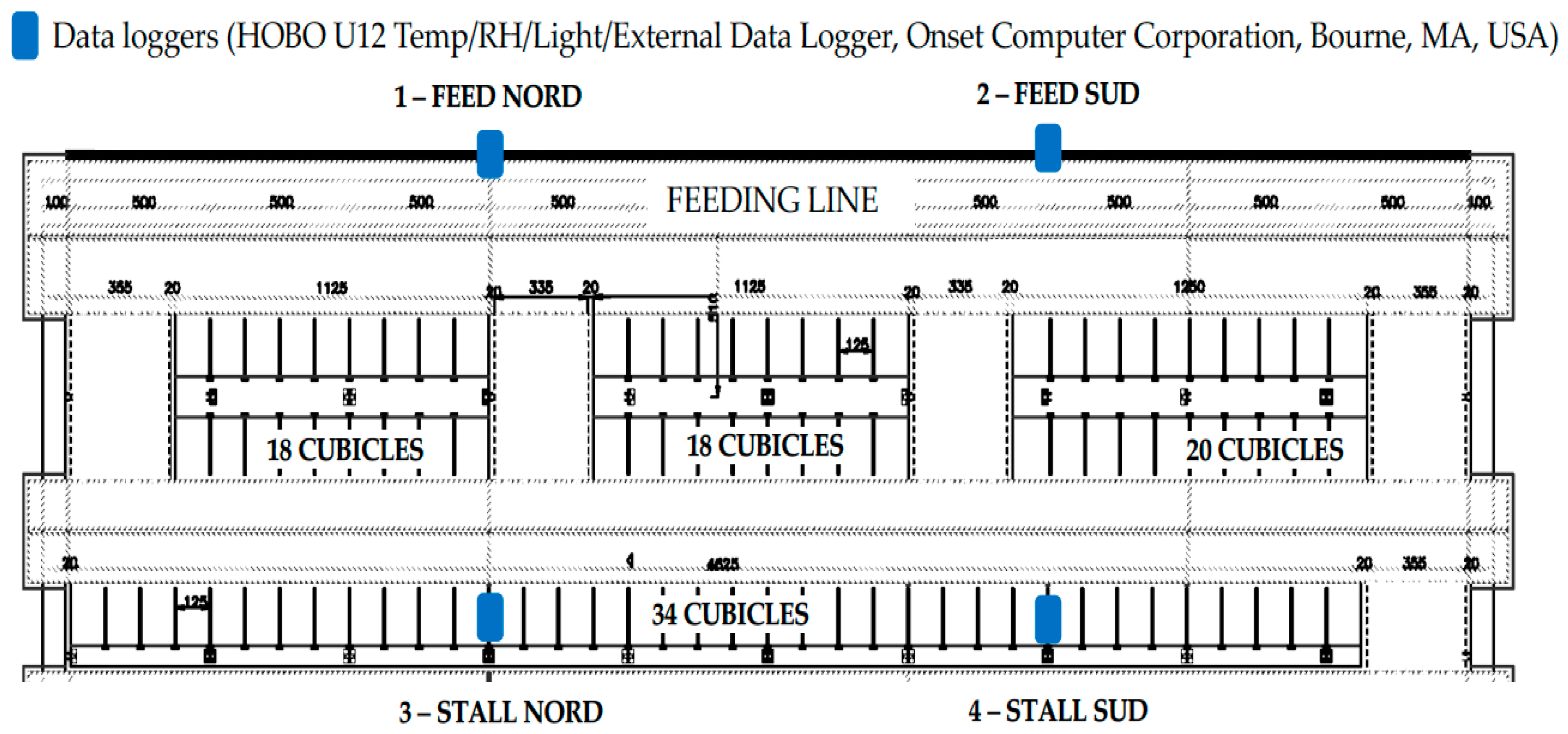
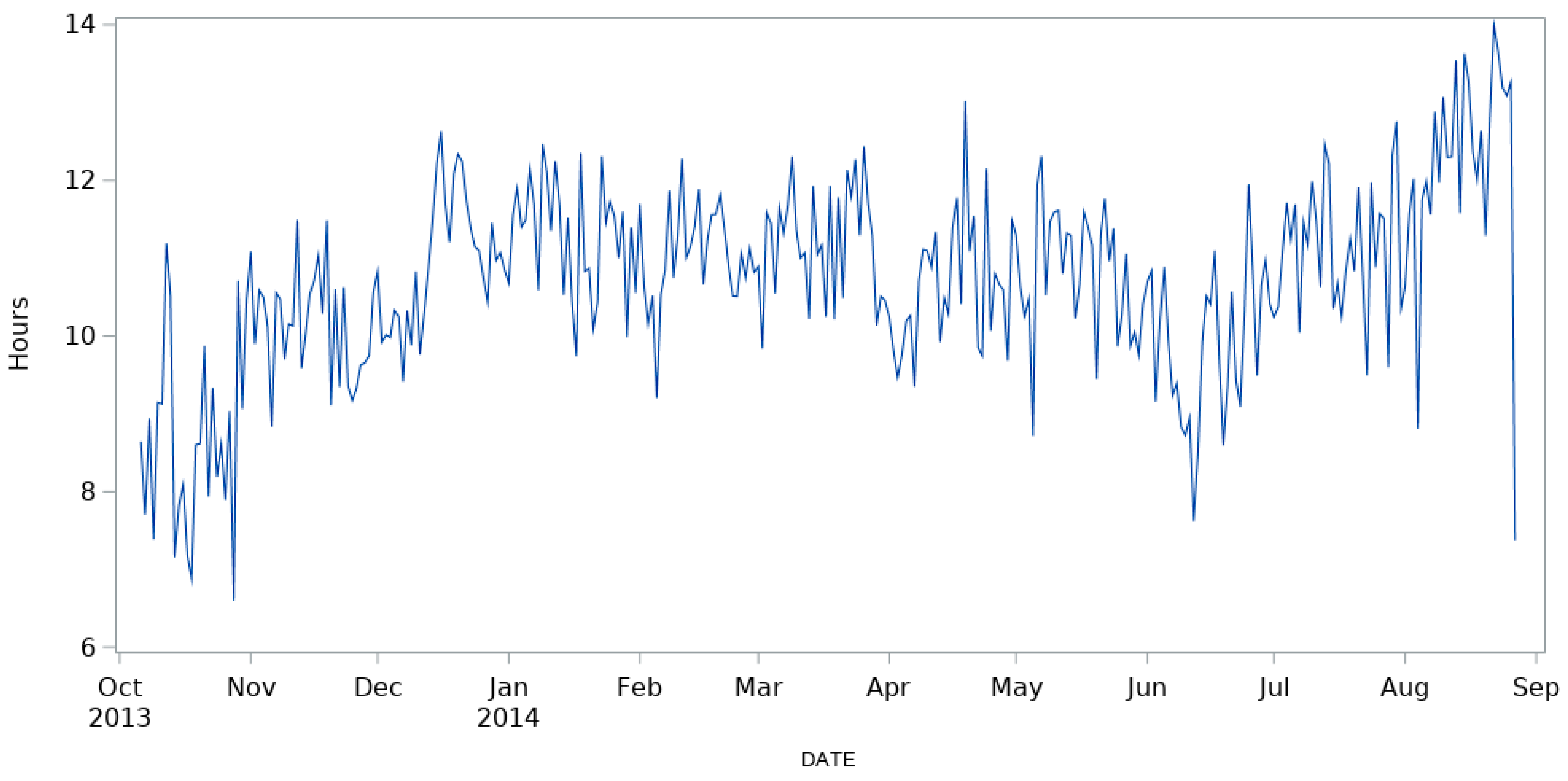
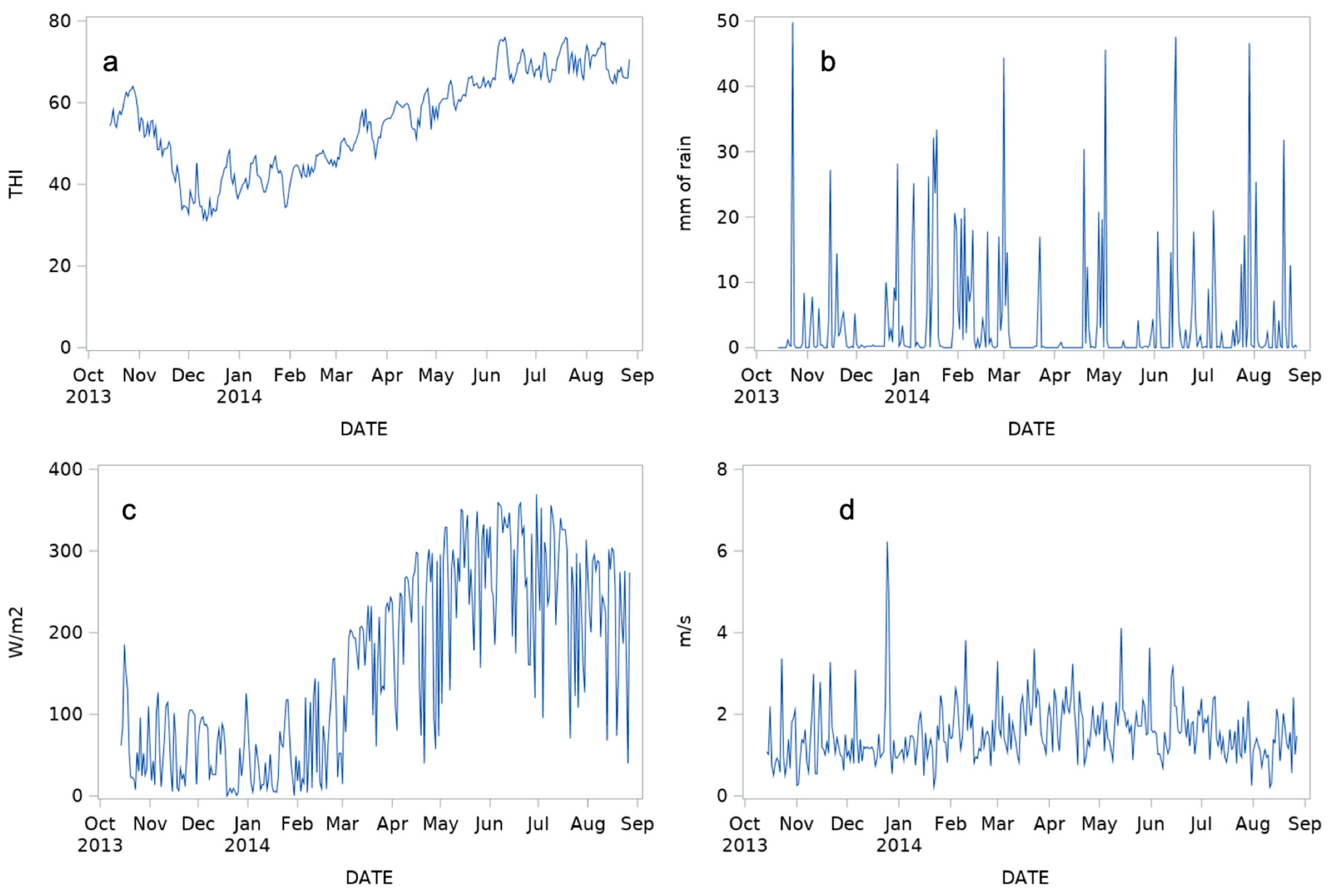
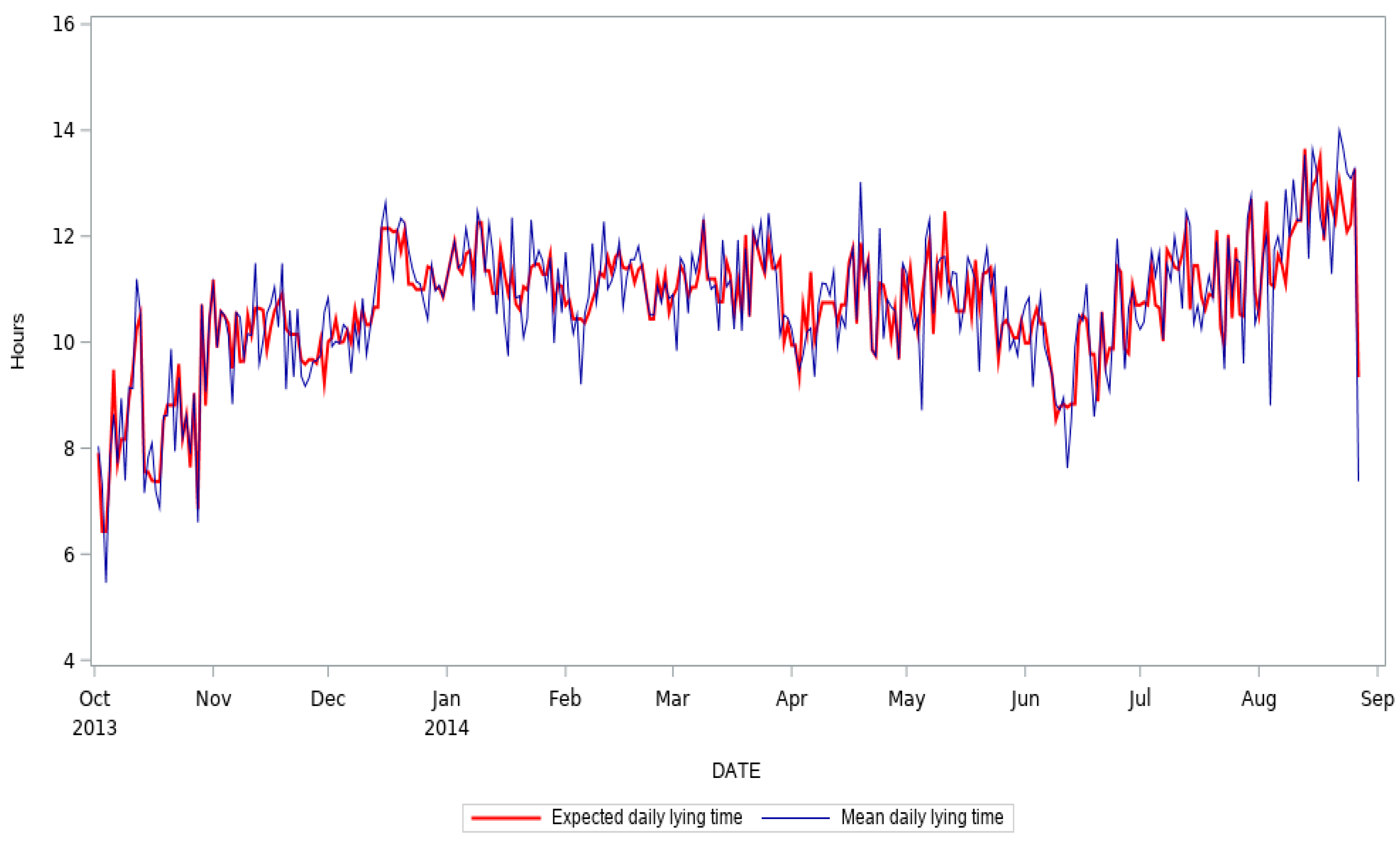

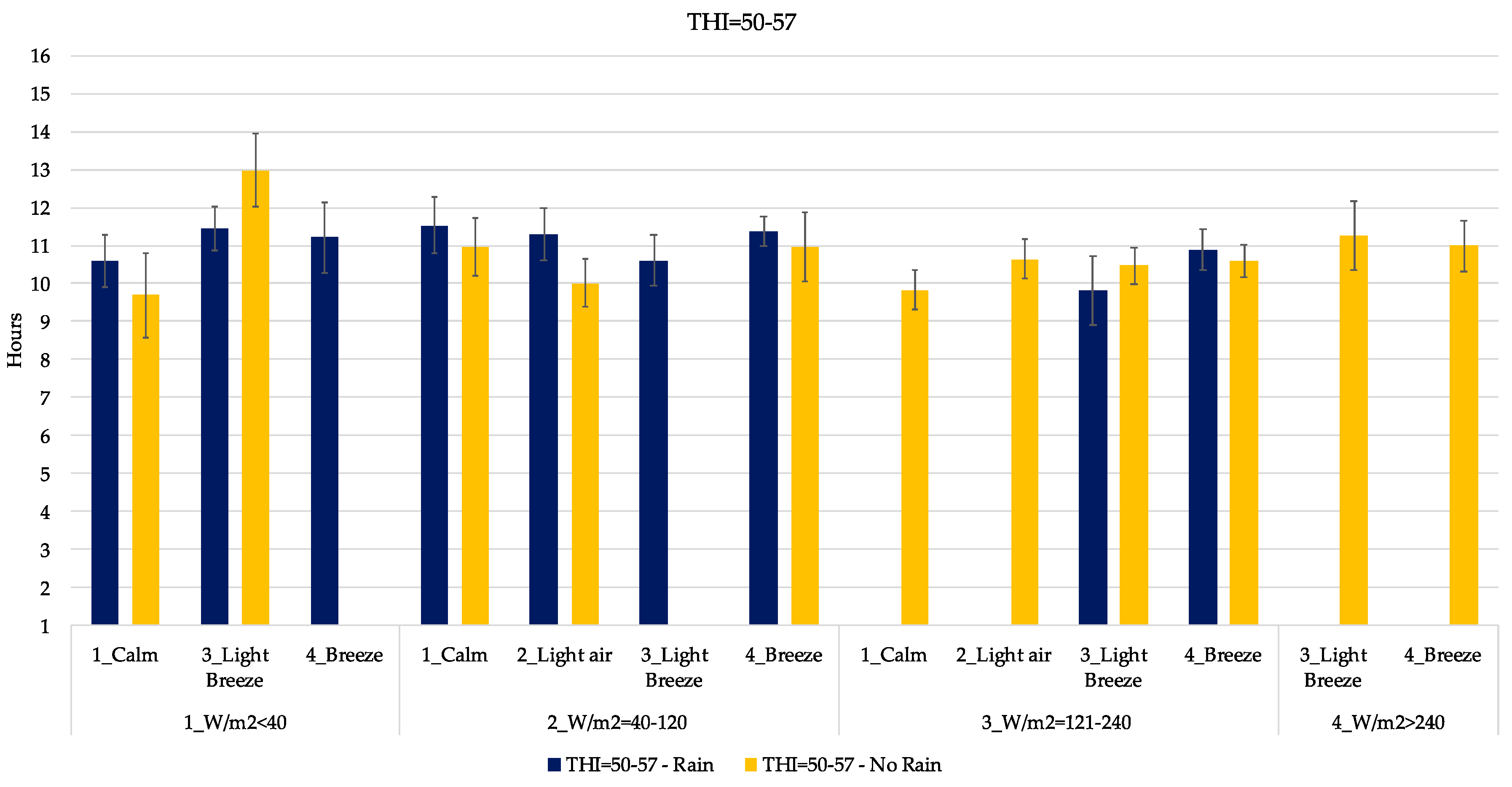

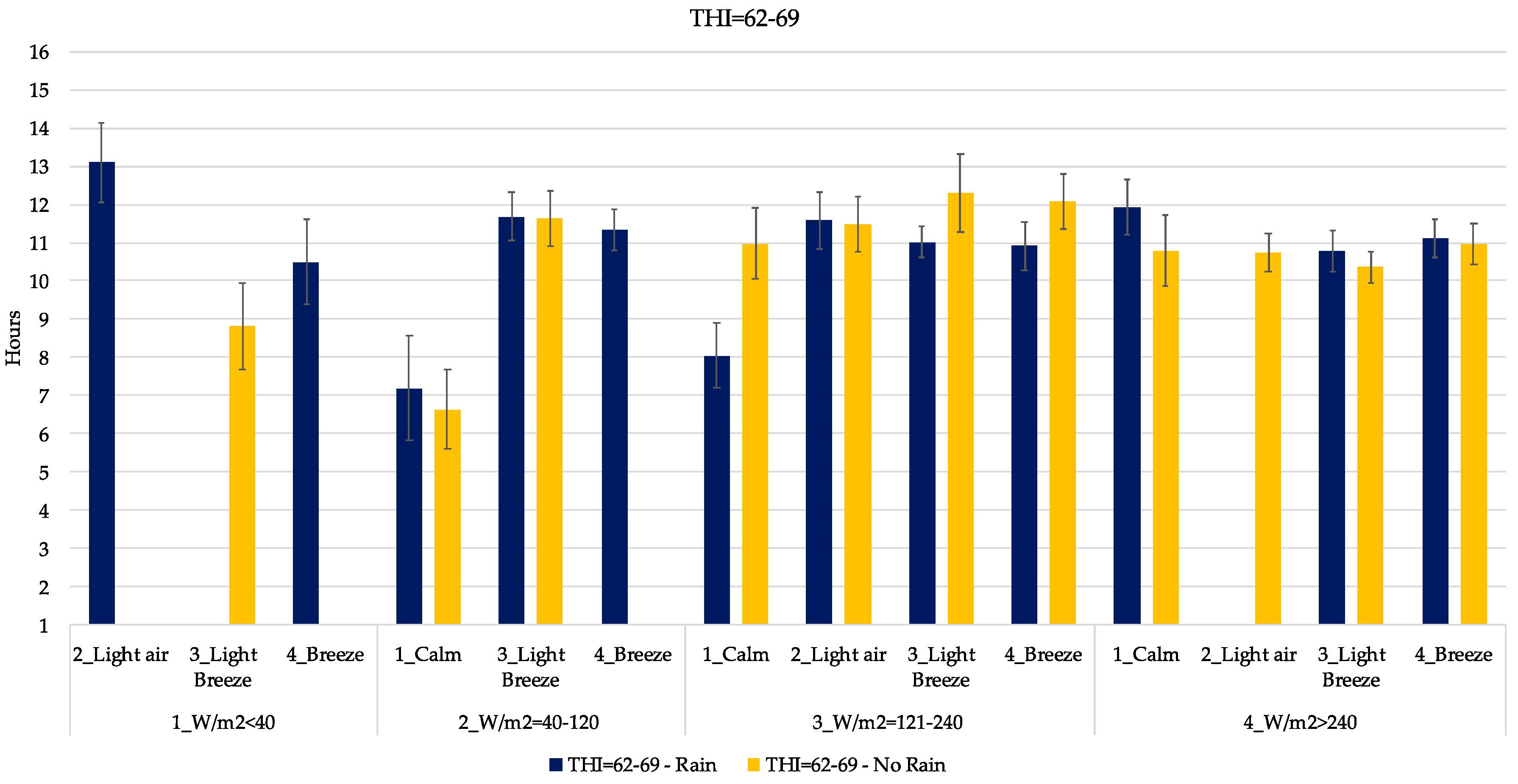
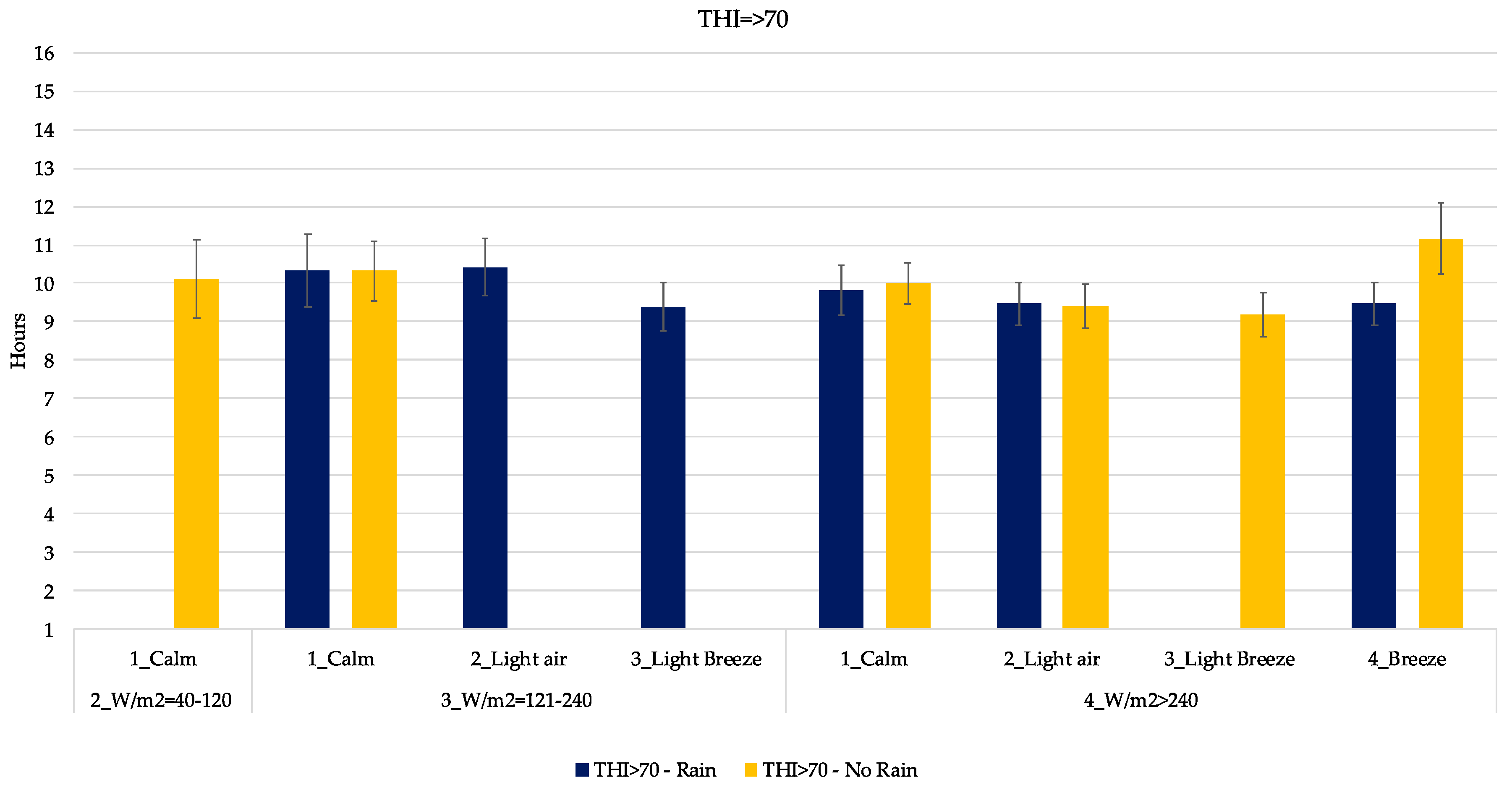
| Parameter | Short Name | N° of Levels | Classes |
|---|---|---|---|
| THI | THI | 5 | THI < 50; THI = 50–57; THI = 58–62; THI = 63–69; THI > 70 |
| Solar radiation | RAD | 4 | W/m2 < 40; W/m2 = 40–120; W/m2 = 121–240; W/m2 > 240 |
| Air Velocity | WIND | 4 | Calm < 1 m/s; Light Air = 1.3–1.8 m/s; Light breeze = 1.3–1.8 m/s; Gentle breeze > 1.8 m/s |
| Precipitation | RAIN | 2 | No Rain = 0 mm; Rain > 0 mm |
© 2019 by the authors. Licensee MDPI, Basel, Switzerland. This article is an open access article distributed under the terms and conditions of the Creative Commons Attribution (CC BY) license (http://creativecommons.org/licenses/by/4.0/).
Share and Cite
Tullo, E.; Mattachini, G.; Riva, E.; Finzi, A.; Provolo, G.; Guarino, M. Effects of Climatic Conditions on the Lying Behavior of a Group of Primiparous Dairy Cows. Animals 2019, 9, 869. https://doi.org/10.3390/ani9110869
Tullo E, Mattachini G, Riva E, Finzi A, Provolo G, Guarino M. Effects of Climatic Conditions on the Lying Behavior of a Group of Primiparous Dairy Cows. Animals. 2019; 9(11):869. https://doi.org/10.3390/ani9110869
Chicago/Turabian StyleTullo, Emanuela, Gabriele Mattachini, Elisabetta Riva, Alberto Finzi, Giorgio Provolo, and Marcella Guarino. 2019. "Effects of Climatic Conditions on the Lying Behavior of a Group of Primiparous Dairy Cows" Animals 9, no. 11: 869. https://doi.org/10.3390/ani9110869
APA StyleTullo, E., Mattachini, G., Riva, E., Finzi, A., Provolo, G., & Guarino, M. (2019). Effects of Climatic Conditions on the Lying Behavior of a Group of Primiparous Dairy Cows. Animals, 9(11), 869. https://doi.org/10.3390/ani9110869






